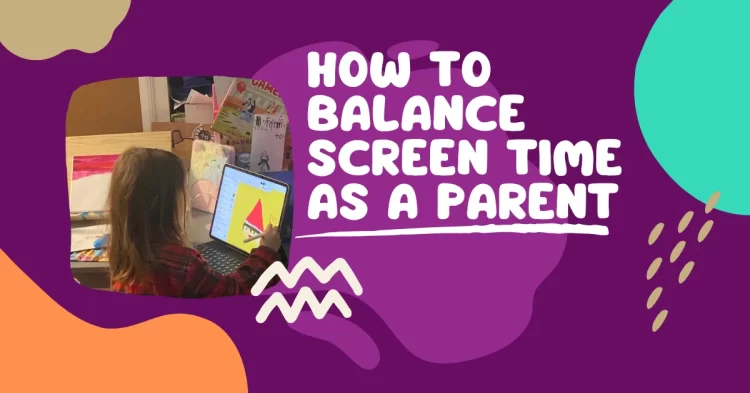When you’re raising kids in a world full of tech, how to balance screen time as a parent becomes one of the most pressing—and sometimes overwhelming—questions of modern family life.
In nerdy, fandom-loving households like ours, screens are more than just a distraction; they’re a way to connect, learn, and have fun together. But where’s the line between healthy and too much?
Here’s what the latest research, expert guidelines, and our own family experience have taught us about finding that balance.
There’s No Single “Right” Amount of Screen Time
For years, parents were told to set strict screen time limits: one hour, two hours, and not a minute more. But both the Canadian Paediatric Society (CPS) and the American Academy of Pediatrics (AAP) now agree: it’s not just about how much time kids spend on screens, but how they’re spending that time and whether it interferes with sleep, school, relationships, or physical activity.
Key expert takeaways:
- Quality matters as much as quantity.
- Focus on balance, not just counting minutes.
- Meaningful, interactive, and social screen time is better than passive, solitary use.
- Occasional squabbles over screens are normal; it’s chronic issues or disrupted routines that signal a problem.
How to Balance Screen Time as a Parent (Our Family’s Approach)
We’ve learned that how to balance screen time as a parent is less about rigid rules and more about mindful routines, open communication, and focusing on what works for your family. Here’s what our experience and research suggest:
1. Prioritize What Matters Most
Before reaching for a device, our family checks in:
- Is homework or reading done?
- Are we getting enough sleep?
- Have we spent time outside or been physically active?
- Have we connected as a family today, screen-free?
When these basics are covered, we feel better about enjoying our favorite fandoms together—on and off the screen.
2. Curate Content, Don’t Just Monitor Time
Not all screen time is created equal! We’re selective about what we watch and play.
Our family’s screen time “yes” list:
- Creative apps (drawing, music, coding)
- Educational documentaries or science shows
- Religious programming that aligns with our faith
- Family movie marathons or fandom events (Star Wars, Marvel, etc.)
- Video calls with out-of-town family

Our “less often” list:
- Endless scrolling or autoplay videos
- Content with lots of ads or questionable messages.
- While we allow YouTube Kids, our little one knows to ask for permission for anything she wants to watch on YouTube.
- Background TV with no one really watching
Tip: Ask your child what they enjoy and why. You might be surprised by their creativity or the skills they’re picking up!
3. Make Screen Time Social
Whenever possible, we turn screens into an opportunity to bond:
- Watch shows together and talk about the story, characters, or science behind the scenes.
- Play games as a team, not just alone.
- Try to co-view Reels or TikTok—learn what your kids love!
- Speaking of those, encourage them to make one when you are having downtime on a day out, but about what you are doing. It shows trust in doing something grown-up, and, for us, the results have been pretty great.
Bonus: Research shows co-viewing and co-playing help children develop critical thinking, media literacy, and stronger connections to parents.
4. Build Flexible Routines Around Screens
Rigid rules often lead to power struggles. Instead, we build routines that work for our family:
- Morning: During the school year, she doesn’t really have time. During summer, we are way more relaxed with this. Again, if you curate what they watch, you will be surprised how they gravitate towards good videos and games on their own.
- After school: Some screen time after homework and chores, balanced with outdoor play or reading.
- Evenings: We try to get her to watch Dr Who or Star Wars with us, but it is ok if she doesn’t want to either. She is a little person with her tastes.
Pro tip: Use the AAP’s Family Media Plan to set expectations together.
5. Create Screen-Free Zones and Times
To keep screens from taking over, we set some boundaries:
- No screens in bedrooms overnight—helps everyone sleep better.
- Tech-free outings: Whether it’s a walk, museum visit, or trip to a con, we try to unplug and be present.
Our Real-Life Example: “Hey Bear!” and Comforting Routines
If you’ve read our post Parenting: Hey Bear!, you know that sometimes screen time is about comfort and routine, not just education. Hey Bear! videos helped our daughter start her day with a smile when she was younger. We discovered her love for round yellow shapes by watching with her, turning passive viewing into an interactive, joyful moment.
And yes, we’re mindful of the downsides—like the ads that sometimes pop up. We use screen time thoughtfully, not as a crutch, and always balance it with books, play, and conversation.
Signs Screen Time Might Need a Reset
Most families have the occasional screen-time squabble. But watch for these signs that it’s time to reassess:
- Kids are irritable or anxious without a device
- Screen use regularly disrupts sleep, meals, or schoolwork
- They’re unwilling to do offline activities they once enjoyed
- You notice negative emotions after screen use
If these show up, have an honest family discussion and adjust routines as needed. We have already talked to her about screen time addiction and the dangers of it. If we didn’t, she would not know.
It’s easy to blame the screen for addiction, but as an AP Computer Science teacher, I often see how kids have never had that conversation before.
How to Balance Screen Time as a Parent: Actionable Tips & Lists

Daily Screen Time Checklist
- Has my child finished homework and chores?
- Did we have a screen-free meal today?
- Did everyone get outside or move their body?
- Did we connect as a family, on or off screen?
- Is screen time interactive, creative, or social?
Conversation Starters
- “What did you like about that game/show?”
- “How did it make you feel?”
- “Want to teach me how to play/watch with you?”
Ways to Turn Screen Time Into Learning
- Watch a documentary and try a related science experiment
- Use a drawing app, then print and hang the art
- Play a history-based game, then look up the real facts together
- Join a fandom event online, then craft costumes or recipes at home
Alternatives to Screens (Inspired by Your Child’s Interests)
- Build LEGO or craft projects based on favorite characters
- Write or draw your own comics
- Read physical books about beloved fandoms.
- Reenact scenes from movies or invent new adventures
Our little one loved Matilda the Musical on Netflix. We had the book, so we gave it to her to read during free reading time at school.
Final Thoughts: It’s All About Intentionality

How to balance screen time as a parent isn’t about striving for perfection or eliminating screens.
It’s about making thoughtful choices, focusing on quality, and ensuring screens are just one piece of a balanced, joyful family life.
In our experience, what matters most is being nerdy, curious, and engaged together, on and off the screen.
Resources
- Common Sense Media: Offers trusted, age-based reviews and ratings for movies, TV shows, books, apps, and games to help families make smart media choices.
- Family Online Safety Institute (FOSI): Resources and tips for keeping families safe online.
- Screen Time – Child Mind Institute: Science-based advice on screen time, media use, and mental health.
How do you balance screen time in your nerdy family? Share your tips and stories in the comments—let’s help each other create awesome, balanced, and geeky homes!
About The Author
Discover more from NolaNerdCouple.com
Subscribe to get the latest posts sent to your email.


